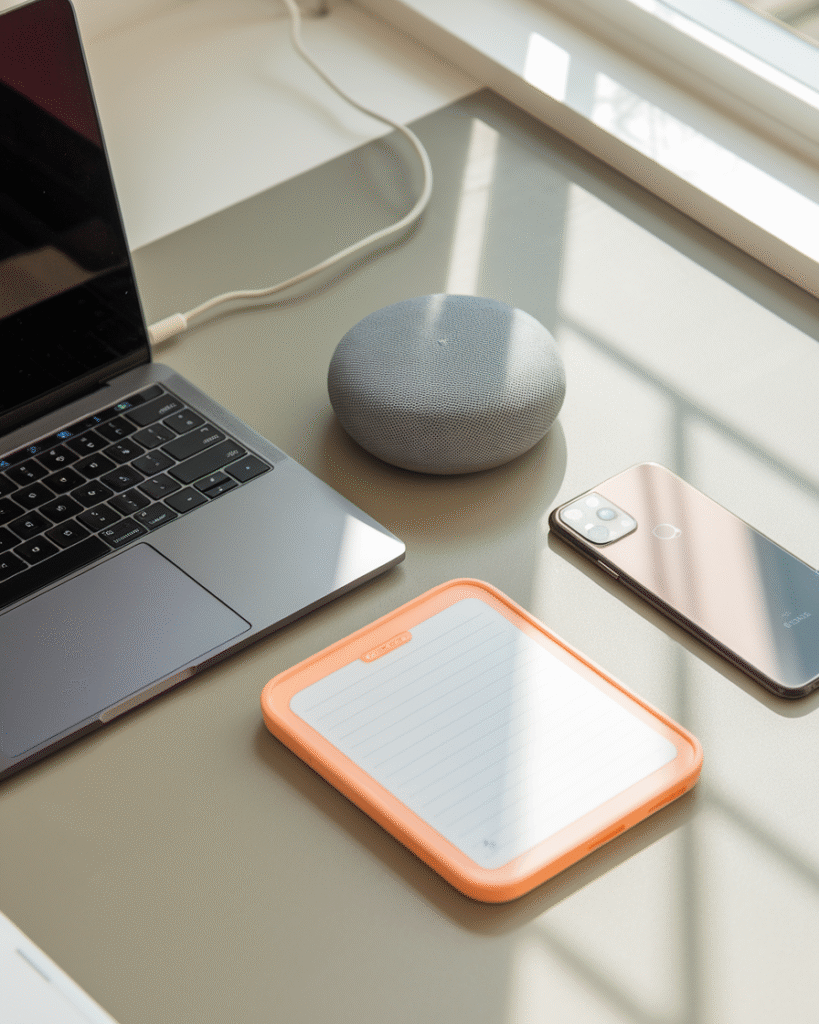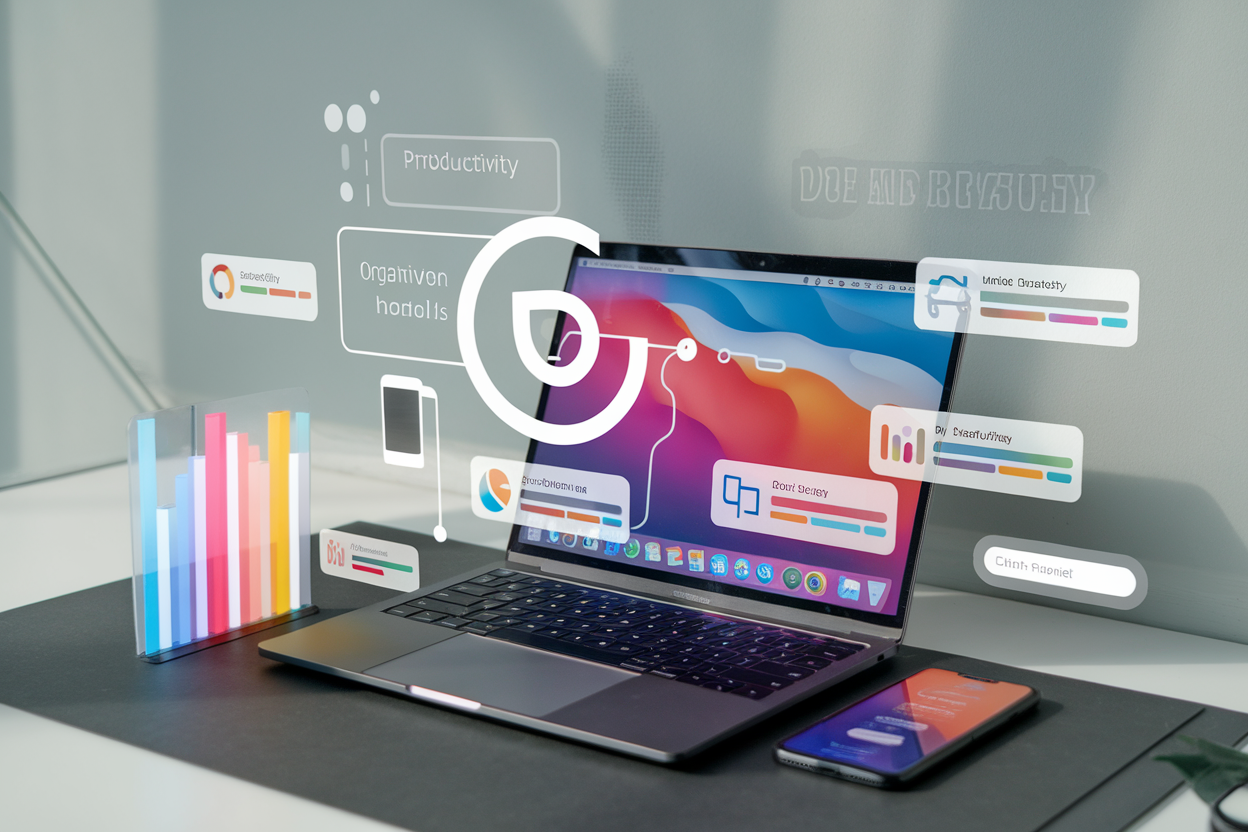Use AI assistants to automate daily tasks, and you’ll start to notice how much lighter your everyday life can feel. We all wake up to the same chaos, checking emails, trying to plan our day, rushing between errands, and juggling too many tabs open on our screens. Now imagine if a personal digital helper quietly handled half of that before you even finished your first cup of coffee. That’s the magic people are beginning to experience with today’s AI assistants.
Let me tell you why this topic matters so much to me. On RiseViaAI, our goal has always been to help ordinary people use technology in ways that make their lives simpler and more meaningful. We started this blog after realizing how many people feel stuck with tech that adds stress instead of saving time. We wanted to fix that by teaching readers how to use AI tools to get things done faster, make better decisions, and create more balance in daily life. Every post we share comes from real experience, not just theory, because we’ve tested these systems ourselves and seen how powerful they can be.
In this article, you’ll learn how to use AI assistants to automate daily tasks at work, home, and in your personal routines. We’ll go through how this technology has evolved, what it can do for you right now, and which tools are worth trying. I’ll also give you a step-by-step plan to start automating parts of your life in a way that feels natural and sustainable. By the end, you’ll understand how to work with AI instead of against it, saving time, mental energy, and even money in the process.
Table of Contents
Table of Contents
Context and Evolution
When people talk about how they use AI assistants to automate daily tasks today, it’s easy to forget how far this technology has come in such a short time. A few years ago, the most advanced automation most of us had was setting a phone reminder or letting a robot vacuum clean the floor. Now, a single AI assistant can answer your messages, manage your schedule, prepare summaries from meetings, and even draft your next blog post before you wake up.
The early stages were simple, almost clunky. Think of Microsoft’s Clippy or those basic website chatbots that followed strict scripts. They weren’t really smart, they just followed patterns. Then came voice recognition, which gave us Siri in 2011 and Alexa in 2014. Those early assistants made people curious, but they still couldn’t understand context. You could ask the weather or play a song, but not much else.
Things changed with machine learning. Suddenly, assistants could learn from you. Google Assistant and Alexa began understanding habits, locations, and speech patterns. They could predict what you needed, not just follow commands. The real leap forward came when conversational AI became mainstream with tools like ChatGPT and Claude. Now, we’re not just telling machines what to do, we’re having full conversations with them.
This evolution has changed the way people think about productivity. Businesses now use AI to handle HR paperwork, manage social media posts, and even run marketing campaigns. At home, families rely on AI to track spending, plan meals, and control energy use. Students use it for studying and research. Creators use it for writing, editing, and generating fresh ideas.
But maybe the most interesting change isn’t about technology at all. It’s about trust. People used to see AI as a novelty, but now they treat it as a personal assistant, something that’s part of their daily rhythm. As the systems continue learning and adapting, they’ll start to feel more like partners who understand our needs and habits. That’s where the future is heading, and it’s happening faster than most people realize.
Deep Explanation of the Core Concept
So what does it really mean to use AI assistants to automate daily tasks? In plain English, it means letting intelligent systems take over repetitive, boring, or time-consuming jobs so you can focus on things that actually matter. It’s about freeing your time, not losing control.
What Are AI Assistants?
An AI assistant is a digital helper powered by artificial intelligence. It understands natural language, learns from your behavior, and performs tasks with little to no supervision. You might use a text-based assistant like ChatGPT or Notion AI, or a voice-based one like Alexa or Google Assistant. The key idea is that these systems understand your intent, not just your words.
For example, if you say, “Remind me to call my client tomorrow morning,” the AI doesn’t just make a note. It checks your schedule, finds an available time, and can even send an email reminder if needed. It listens, interprets, and acts almost like a human assistant who knows your habits.
Comparing the Old Way vs. the Smart Way
Here’s how life used to look compared to how it looks when you start using AI assistants to automate daily tasks.
| Aspect | Traditional Way | AI-Driven Way |
|---|---|---|
| Task Entry | Manual typing or reminders | Simple voice or text commands |
| Scheduling | Add events by hand | AI finds free slots and books automatically |
| Emails | Typed one by one | Auto-generated drafts with context |
| Research | Endless browsing | Quick summaries from multiple sources |
| Repetition | Tedious routines | Set-and-forget automation |
| Learning | Static tools | Systems that adapt to your patterns |
| Efficiency | Dependent on effort | Grows with time and feedback |
The shift is incredible. Old systems needed you to work harder. New systems learn from how you work and help you work less. That’s the real purpose of automation not to make people lazy, but to make life more manageable.
The Psychology of Letting Go
Many people hesitate at first when they start using AI assistants to automate daily tasks because they don’t want to lose control. It’s a normal feeling. Humans like to handle everything themselves. But when you delegate the right tasks, you’re not giving up control, you’re just choosing smarter ways to spend your energy. The time you save can go into thinking, resting, or doing something creative. Once you see that balance, it’s hard to go back.
Why This Matters
We live in an age where attention is the new currency. The people who win aren’t the ones who do the most, but the ones who focus best. Using AI assistants to automate daily tasks helps you cut through clutter, stay organized, and reclaim the hours you’ve been losing to distractions. Whether you’re running a business, managing a household, or studying full-time, automation helps you stay centered and productive without working yourself to exhaustion.
Real-World Applications and Impact
When you start to use AI assistants to automate daily tasks, the changes you notice go far beyond simple convenience. It’s not just about saving time. It’s about reshaping how you think, how you work, and even how you live.
Let’s look at how this is playing out in the real world.
In the Workplace
Companies of every size now use AI assistants to automate daily tasks like scheduling meetings, answering emails, generating reports, and even preparing presentations. Sales teams, for example, are saving hours every week by letting AI organize client data and craft proposals automatically. If you look at the strategies shared in this detailed guide, you’ll see how AI can help create stronger, data-backed presentations that actually win clients.
Administrative work is another area being transformed. Instead of spending hours managing spreadsheets, tools like Notion AI and ClickUp AI handle repetitive tasks instantly. Project managers are now delegating data entry, note summarization, and deadline tracking to AI assistants that can keep everyone on schedule without needing constant supervision.
In Creative Work
Writers, designers, and marketers are also discovering how powerful it is to use AI assistants to automate daily tasks that normally slow down their creative process. A good example is content creation. Instead of writing product descriptions from scratch, many online stores now rely on AI to generate polished, SEO-friendly copy. There’s even a full step-by-step guide on that over at RiseViaAI, showing how businesses can create high-performing listings in minutes.
And it’s not limited to writing. Creators are using AI to generate artwork ideas, edit videos, and schedule social posts based on engagement patterns. The more they use AI assistants to automate daily tasks, the more creative space they have for storytelling and strategy.
In Personal Life
This is where it gets really interesting. Regular people now use AI assistants to automate daily tasks that used to take half their evening. Imagine waking up and having your calendar updated, your grocery list organized, and your emails sorted automatically. AI can even track your budget or suggest recipes based on what’s already in your fridge.
Some people use tools like Google Assistant or Amazon Alexa to manage home routines, while others combine AI-powered apps with smart home devices. You can literally tell your assistant, “Prepare tomorrow’s to-do list,” and have it sync with your phone, planner, and reminders.
The impact of this shift is emotional too. People feel less stressed, more organized, and more in control of their time. That’s why experts from trusted platforms like Harvard Business Review and Forbes say that automation will become a core life skill in the next decade. It’s no longer about being tech-savvy, but about being time-savvy.
Step-by-Step Framework

If you want to use AI assistants to automate daily tasks effectively, it’s best to start with a clear framework. Too many people dive in, try a few tools, and give up when they feel overwhelmed. The secret is to build automation one layer at a time.
Here’s a step-by-step roadmap to help you get started.
Step 1: Identify Your Repetitive Work
Take a close look at your week. What are the tasks you repeat daily or weekly that don’t really require deep thinking? Examples include writing emails, posting social updates, data entry, or managing your calendar. These are perfect starting points for automation.
Step 2: Choose One AI Assistant
Pick one platform to start with. Don’t try five at once. For text and creative automation, something like ChatGPT or Notion AI works well. For workflow management, try ClickUp AI or Motion. For voice and scheduling, Google Assistant or Siri are great entry points.
When you use AI assistants to automate daily tasks, think of them like employees. They learn from you. The clearer your instructions, the better their results.
Step 3: Start Small
Begin with one use case. For instance, ask your assistant to summarize your emails every morning or create a shopping list for the week. See how accurate it is and refine from there. Most people get frustrated only because they expect perfection from day one.
Step 4: Build Routine Triggers
Once you trust the system, connect your AI assistant with other apps. For example, you can set up automations using Zapier or IFTTT that tell your assistant, “When I receive a message with the word ‘meeting,’ add it to my calendar.” Small triggers like these can save hours over time.
Step 5: Teach Context
AI assistants work best when they know your patterns. Spend a few minutes each week teaching them your tone, preferences, or key projects. When you use AI assistants to automate daily tasks consistently, they become smarter, understanding your habits and adjusting automatically.
Step 6: Combine Human Touch with Automation
The goal isn’t to remove yourself from your workflow completely. It’s to create balance. Let AI handle the mechanics while you handle creativity and judgment. Think of it as teamwork the AI sets the stage, and you perform.
Step 7: Review and Improve
Every month, check what’s working and what’s not. Delete automations that no longer help. Add new ones where you waste time. Over time, you’ll build a seamless rhythm where your digital assistant almost feels like an invisible co-worker.
Step 8: Stay Updated
The world of AI moves fast. Subscribe to reliable sites like TechCrunch or MIT Technology Review to stay informed about new tools and updates. The more you learn, the better you’ll be at finding smarter ways to use AI assistants to automate daily tasks.
Tools, Platforms, and Ecosystem
When people first start trying to use AI assistants to automate daily tasks, they often ask, “Which tools should I even start with?” There’s no single answer because it depends on your goals. But here are some of the most practical tools and platforms across different categories.
1. ChatGPT
One of the most versatile assistants for writing, brainstorming, and organization. You can use it to draft emails, generate content ideas, or plan your week. It’s also great for personal journaling or creating summaries of long documents.
2. Notion AI
Perfect for productivity lovers. It can take meeting notes, track projects, and even write blog posts inside your workspace. When you use AI assistants to automate daily tasks with Notion, you get an integrated hub that keeps everything in one place.
3. ClickUp AI
Built for teams and project management. It automates updates, meeting summaries, and task breakdowns. For business owners, it’s an all-in-one solution for efficiency.
4. Zapier
A must-have tool if you want to connect multiple apps together. Zapier creates automatic triggers between platforms, like syncing your calendar, Google Sheets, and CRM system.
5. Google Assistant
Still one of the best for voice-based daily help. You can set reminders, control smart devices, or get quick answers hands-free. It’s especially useful for managing routines while driving or cooking.
6. Motion
An underrated app that schedules your entire day automatically. It learns your patterns and rearranges tasks if something unexpected happens.
7. Grammarly AI
For anyone who writes regularly, Grammarly now offers AI-powered tone rewrites and clarity suggestions. It’s like having an editor who never sleeps.
8. Perplexity AI
An excellent research tool that finds verified information fast. If you want trustworthy summaries without endless Google searches, this is a solid option.
9. Otter.ai
Perfect for meetings or lectures. It transcribes audio in real time and summarizes key points automatically. Professionals use it to skip note-taking entirely.
10. Reclaim.ai
This one focuses on smart time management. It rearranges your calendar automatically based on deadlines and energy levels. When you use AI assistants to automate daily tasks with Reclaim, you’ll feel like your schedule finally works for you, not against you.
Each of these tools fits a different part of life personal, creative, or professional. You don’t need all of them. Just pick two or three that align with your routine, and you’ll immediately see the difference in how much smoother your days become.
Data, Research, and Expert Insights

The growing number of people who use AI assistants to automate daily tasks is no coincidence. It’s backed by data, real-world research, and expert insights from those who study how humans interact with intelligent systems. The shift from manual work to smart automation is happening across industries faster than anyone expected.
According to multiple global studies, more than half of all digital professionals now use AI assistants to automate daily tasks in some way. That includes everything from scheduling and writing to analyzing reports and managing teams. What’s most interesting is how quickly this adoption curve is accelerating. Even small businesses and freelancers are starting to see automation not as a luxury, but as a necessity.
Experts in technology and behavioral science often highlight one key reason why this works so well. When you use AI assistants to automate daily tasks, you reduce what psychologists call “cognitive load.” This simply means you’re freeing your brain from constant micro-decisions like when to send an email or what to prioritize first. Over time, this small shift results in lower stress and sharper focus.
Several university studies also show that people who consistently use AI assistants to automate daily tasks report feeling more creative. It makes sense. When your assistant handles the repetitive work, your mind can finally focus on bigger ideas. You think more clearly because you’re not drowning in small details all day.
Researchers are also noticing a new trend. People aren’t just using AI assistants at work anymore. They’re using them for personal health tracking, fitness reminders, and even emotional check-ins. Some assistants can analyze sleep patterns, recommend routines, or guide short breathing exercises. This proves that automation doesn’t have to make life robotic. When used right, it can make life more human.
Future Outlook and Predictions
If we look ahead, the future for those who use AI assistants to automate daily tasks is bright and full of opportunity. What started as a simple idea of asking your phone for the weather has evolved into full lifestyle automation. And it’s just the beginning.
In the next few years, AI assistants will likely become far more personalized. Instead of giving generic advice, they’ll understand your exact needs and goals. For instance, your assistant could plan your meals based on your health goals, track your sleep, organize your day, and even suggest when to take breaks. It will know your routine so well that it will adjust your schedule if it senses you’re overwhelmed.
Another exciting direction is multi-assistant collaboration. Imagine your work AI assistant automatically syncing with your home assistant. While one organizes your projects and emails, the other adjusts your environment for focus by lowering noise or setting reminders. This kind of harmony between digital helpers will redefine productivity.
We’ll also see more people use AI assistants to automate daily tasks in areas that aren’t yet fully digital. For example, in education, teachers might have assistants that personalize lesson plans for each student. In healthcare, patients could receive daily check-in messages that track symptoms and alert doctors if something seems off. Even small farmers could use AI to monitor soil health, weather, and crops with little effort.
Of course, the growing presence of AI assistants brings questions about privacy, transparency, and control. The future depends on how well companies design systems that are trustworthy and secure. As these technologies evolve, it’s essential for users to stay aware of what data they share and how it’s used.
Still, the long-term outlook is incredibly positive. People who learn how to use AI assistants to automate daily tasks today will have a major advantage tomorrow. They’ll be faster, better organized, and more adaptable in a world that’s only getting more complex.
Mistakes, Myths, and Misconceptions
Whenever something new becomes popular, a few myths follow. The same goes for those trying to use AI assistants to automate daily tasks. Many people misunderstand how these tools work or what they can actually do. Let’s clear up the biggest ones.
Mistake 1: Expecting Perfection from the Start
One of the most common mistakes people make when they first use AI assistants to automate daily tasks is expecting flawless results right away. The truth is, it takes a bit of learning on both sides. AI needs time to understand your preferences, and you need time to learn how to phrase your requests clearly. Think of it like training a new employee. The more feedback you give, the better it gets.
Mistake 2: Automating Everything Too Fast
Another mistake is trying to automate every single part of your day at once. It might sound appealing, but it usually backfires. The best approach is to start small. Pick one routine, like email organization or calendar updates, and build from there. This keeps the process smooth and sustainable.
Myth 1: Using AI Means Losing Control
Some people still believe that if they use AI assistants to automate daily tasks, they’ll lose control of their work or privacy. That’s simply not true. You’re still the decision-maker. AI just helps carry out your choices more efficiently. You can stop, pause, or adjust any automation whenever you want.
Myth 2: AI Assistants Replace Human Jobs
It’s also a myth that AI assistants are here to take over people’s roles. They’re not replacing creativity, empathy, or strategy. They’re removing the tedious stuff that prevents you from doing meaningful work. Think of them as support systems, not competitors.
Mistake 3: Ignoring Security Settings
People often forget that even AI assistants need security hygiene. Using weak passwords, failing to check app permissions, or skipping privacy settings can lead to unnecessary risks. When you use AI assistants to automate daily tasks, make sure you always know which data they can access and how it’s stored.
Myth 3: Only Tech Experts Can Use Them
This one is completely false. You don’t need to be a programmer to use AI assistants to automate daily tasks. Most tools today are designed for everyday users. You can talk to them in normal language and they’ll understand. The best part is that as you use them more, they start learning your style, making it feel even easier.
The truth is that anyone can benefit from using AI assistants. Whether you’re managing a household, running a small business, or just trying to keep up with life, automation can make your days smoother and more focused.
Advanced Tips and Pro Strategies

Once you’ve started to use AI assistants to automate daily tasks, you’ll quickly notice how much time you’ve been wasting on little things. But after the basics, there’s a next level where you can really make these tools work like a personal team. The key is not just using them but teaching them to think and respond in ways that match your lifestyle.
The first pro tip is to focus on personalization. When you use AI assistants to automate daily tasks, make sure to feed them specific details about your preferences, tone, and goals. The more context they have, the better they perform. For example, if you always start your mornings with planning, teach your assistant to summarize your top priorities and weather forecast right after you wake up. Small customizations like this turn automation into habit support.
The second tip is to build layers of automation. Once you use AI assistants to automate daily tasks like scheduling or writing emails, connect them with other apps. Let your calendar, notes, and reminders all talk to each other. The goal is to create a digital rhythm where everything stays updated without you lifting a finger.
Third, don’t be afraid to experiment. People who get the most out of these tools test different prompts, formats, and methods until they find what works best. When you use AI assistants to automate daily tasks regularly, you start understanding what instructions produce the clearest and fastest results. It’s like learning a language. The more you practice, the smoother the communication becomes.
Another smart approach is to mix human creativity with machine logic. Let AI handle data, structure, and repetition, but keep yourself in charge of decisions and emotional touch. When you use AI assistants to automate daily tasks, always remember that your intuition still matters. You’re the guide, and AI is the helping hand.
Finally, measure your progress. Track how much time you save or how your workflow improves after a few weeks. When you use AI assistants to automate daily tasks with intention, you’ll see patterns that reveal what’s really helping and what’s just noise. Refine as you go, and soon you’ll feel like your entire routine runs on quiet, invisible help that keeps everything flowing smoothly.
Conclusion
If there’s one thing to take away, it’s that learning how to use AI assistants to automate daily tasks is no longer optional. It’s becoming a basic life skill. These tools aren’t just about productivity; they’re about peace of mind. When you let technology handle the clutter, you get to focus on what truly matters.
Start small. Let your assistant help with scheduling, reminders, or writing. Build confidence. Then expand slowly until your entire day feels organized and calm. The more you use AI assistants to automate daily tasks, the more you’ll realize that this isn’t about machines replacing people. It’s about giving yourself more time to think, to create, and to live.
The truth is, automation done right feels personal. It blends into your habits quietly until you can’t imagine life without it. When you use AI assistants to automate daily tasks consistently, you take back control of your time, your focus, and your energy. That’s what real productivity looks like not just doing more, but living better.
FAQ Section
How do I choose which assistant to start with?
The best one depends on your goals. If you want to organize your personal life, start with a simple mobile assistant. If your focus is work productivity, try one built into your planning tools. No matter which one you pick, the important thing is to use AI assistants to automate daily tasks that already take up too much time.
Are there risks in relying too much on automation?
Yes, but only if you let it replace your judgment. The best approach is balance. Use AI assistants to automate daily tasks, but always stay aware of what’s happening. You should still review results and make key decisions yourself.
Do I need any technical knowledge to use AI assistants to automate daily tasks?
Not at all. Most systems today are designed for normal users. You can type or speak in plain language, and the assistant will understand what you need. Anyone can learn how to use AI assistants to automate daily tasks with just a few tries.
What are the main benefits when people use AI assistants to automate daily tasks?
The biggest advantage is time freedom. When you use AI assistants to automate daily tasks, you cut out repetitive work that drains focus. This gives you more energy for things that actually matter, like creative projects, rest, or family time.



